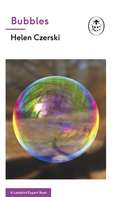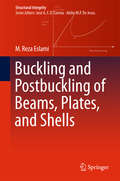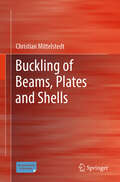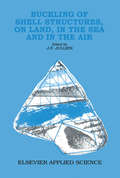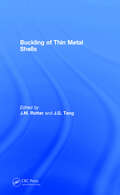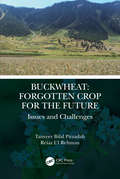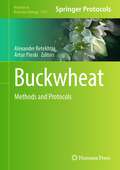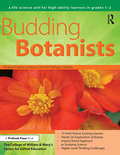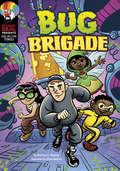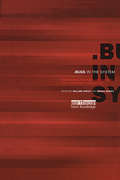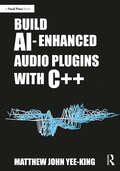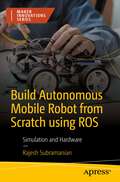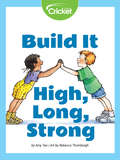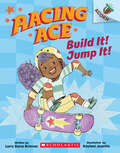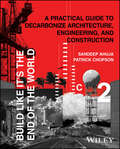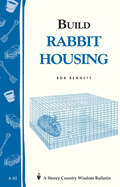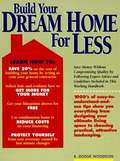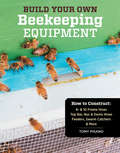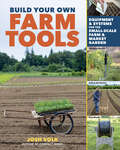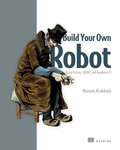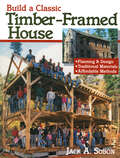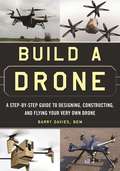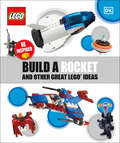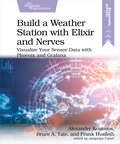- Table View
- List View
Bubbles: A Ladybird Expert Book (The Ladybird Expert Series #24)
by Helen CzerskiPart of the new Ladybird Expert series, Bubbles is a clear, surprising and entertaining introduction to the science of bubbles. Bubbles are beautiful, ephemeral, fun, fragile, jolly and slightly unpredictable. We're all familiar with them, but we don't often ask what they actually are. The great scientists of the Western world - Robert Hooke, Isaac Newton, Lord Rayleigh and more - studied bubbles seriously. They recognised that they had a lot to say about the nature of the physical world, and they poked, prodded and listened to find out what it was. In the years since, we've learned that this bulbous arrangement of liquid and gas does things that neither the gas or the liquid could do by itself. Written by the celebrated physicist and oceanographer Helen Czerski, Bubbles explores how everything from the way drinks taste to the Earth's temperature are influenced by bubbles. This book has a message: never underestimate a bubble!Written by the leading lights and most outstanding communicators in their fields, the Ladybird Expert books provide clear, accessible and authoritative introductions to subjects drawn from science, history and culture.For an adult readership, the Ladybird Expert series is produced in the same iconic small hardback format pioneered by the original Ladybirds. Each beautifully illustrated book features the first new illustrations produced in the original Ladybird style for nearly forty years.
Buckling and Postbuckling of Beams, Plates, and Shells (Structural Integrity #1)
by M. Reza EslamiThis book contains eight chapters treating the stability of all major areas of the flexural theory. It covers the stability of structures under mechanical and thermal loads and all areas of structural, loading and material types. The structural element may be assumed to be made of a homogeneous/isotropic material, or of a functionally graded material. Structures may experience the bifurcation phenomenon, or they may follow the postbuckling path. This volume explains all these aspects in detail. The book is self-contained and the necessary mathematical concepts and numerical methods are presented in such a way that the reader may easily follow the topics based on these basic tools. It is intended for people working or interested in areas of structural stability under mechanical and/or thermal loads. Some basic knowledge in classical mechanics and theory of elasticity is required.
Buckling of Beams, Plates and Shells
by Christian MittelstedtThis book contains an introduction to the fundamental principles of the theory of stability of elastic bodies and structures. Beginning with very basic explanations of stability problems, this book starts with the treatment of systems of rigid beams, before beams under normal force and bending as well as the classical field of beam buckling are treated. For the case of beam buckling, an energetic consideration then follows, which forms the basis for a series of approximation methods. In addition to beam buckling, the stability cases of lateral-torsional buckling and lateral buckling are also of fundamental importance, to each of which a separate chapter is dedicated. This is followed by a discussion of plate buckling, and the book concludes with an introduction to shell buckling. This book is aimed at students at technical colleges and universities, as well as engineers in practice and researchers in the engineering sciences.
Buckling of Shell Structures, on Land, in the Sea and in the Air
by J. F. JullienThis book provides better inputs for improvement of the buckling load predictions of stiffened cylindrical shells subjected to combined loading. It is based on the International Colloquium Buckling of shell structures, on land, in the sea and in the air, Lyon, France, 17 September 1991.
Buckling of Thin Metal Shells
by J. G. Teng J. M. RotterThin-walled metal shell structures are highly efficient in their use of material, but they are particularly sensitive to failure by buckiling. Many different forms of buckling can occur for different geometries and different loading conditions. Because this field of knowledge is both complex and industrially important, it is of great interest and c
Buckwheat: Issues and Challenges
by Reiaz Ul Rehman Tanveer Bilal PirzadahBuckwheat: Forgotten crop for the Future offers an overview of this globally important crop, including its history, origin and its importance to functional food sector. Due to its short growth span, ability to grow at higher altitudes and superior quality of its protein, buckwheat is considered as an important crop for addressing global food requirements. The book also provides upto date information on the abiotic stress tolerance properties of the crop including its hyperaccumulating potential. The book talks about the issues and challenges being faced for adopting this crop and the ways to address and overcome these limitations. The book guides the readers through different varietal adaptations and provides information on appropriate research directions. This book would serve as an ideal guide for researchers and advanced-level students seeking better understanding of the buckwheat crop. Introduces the buckwheat’s origin, history and diversity Summarizes the distribution of buckwheat species around the world Presents agro-techniques and cultivation practices of buckwheat Explores the nutraceutical potential of buckwheat Includes adaptation of buckwheat towards different environmental factors affecting growth and production Discusses the reasons for declining buckwheat production Addresses the strategies for buckwheat crop improvement
Buckwheat: Methods and Protocols (Methods in Molecular Biology #2791)
by Alexander Betekhtin Artur PinskiThis detailed volume describes the most recent methodology for buckwheat research. Buckwheat serves as a promising functional food source containing various phenolic compounds, such as rutin, quercetin, and C-glycosylflavones, which have a positive therapeutic or dietary effect for promoting human health. This book explores techniques for studying this pseudocereal, namely the two most widely cultivated species, F. esculentum (common buckwheat) and F. tataricum (Tartary buckwheat). Written for the highly successful Methods in Molecular Biology series, chapters include introductions to their respective topics, lists of the necessary materials and reagents, step-by-step and readily reproducible laboratory protocols, and tips on troubleshooting and avoiding known pitfalls. Practical and comprehensible, Buckwheat: Methods and Protocols is an ideal guide for plant scientists working in this field.
Budding Botanists: A Life Science Unit for High-Ability Learners in Grades 1-2
by Clg Of William And Mary/Ctr Gift EdBudding Botanists, a life science unit for grades 1-2, engages students in an investigation of plant life as they assume the role of botanists. Team members seek to understand the structure, nature, and life cycle of plants, and to answer questions such as “How can plants be used to fuel cars?”Winner of the 2008 NAGC Curriculum Studies Award, Budding Botanists was developed by the Center for Gifted Education at The College of William and Mary, to offer advanced curriculum supported by years of research. The Center's materials have received national recognition from the United States Department of Education and the National Association for Gifted Children, and they are widely used both nationally and internationally.Each of the books in this series offers curriculum that focuses on advanced content and higher level processes. The science units contain simulations of real-world problems, and students experience the work of real science by using data-handling skills, analyzing information, and evaluating results. The mathematics units provide sophisticated ideas and concepts, challenging extensions, higher order thinking skills, and opportunities for student exploration based on interest. These materials are a must for any teacher seeking to challenge and engage learners and increase achievement.Grades 1-2
Bug Brigade (Michael Dahl Presents: Side-Splitting Stories)
by Matthew K. ManningThey're the world's greatest heroes! The grim avengers of the night! The planet's first line of defense against supervillains and alien threats! They're . . . the Bug Brigade? Doug, Josie, Kira, and Reginald were all normal sixth graders at the start of their field trip to the Blue Mountain Science Museum. Proud members of the Bug Society of Littleton, the friends are thrilled to explore a private wing of the museum where they can learn all about their favorite insects. But when they get mixed up in a scientist's experiment involving radioactive bugs, they find themselves in over their heads (and antennas!). The Bug Brigade must swarm together to fight off an evil insect villain. Will their newfound buggy superpowers be up to the test?
Bugs in the System: Redesigning the Pesticide Industry for Sustainable Agriculture
by William Vorley Dennis KeeneyThis important, interdisciplinary contribution to the 'greening' business debate looks at one of the most environmentally controversial industries - the chemical pesticide industry. If that sector can be put on to an environmentally sustainable footing, then the same may be possible for virtually all of industry. As business and environmental trends turn the pesticide industry's focus to biotechnology and seed engineering, this book examines the extent to which the industry is prepared to exploit new business opportunities in a more regenerative agriculture and draws attention to the industry's economic, environmental and social responsibilities.
Build AI-Enhanced Audio Plugins with C++
by Matthew John Yee-KingBuild AI-Enhanced Audio Plugins with C++ explains how to embed artificial intelligence technology inside tools that can be used by audio and music professionals, through worked examples using Python, C++ and audio APIs which demonstrate how to combine technologies to produce professional, AI-enhanced creative tools.Alongside a freely accessible source code repository created by the author that accompanies the book for readers to reference, each chapter is supported by complete example applications and projects, including an autonomous music improviser, a neural network-based synthesizer meta-programmer and a neural audio effects processor. Detailed instructions on how to build each example are also provided, including source code extracts, diagrams and background theory.This is an essential guide for software developers and programmers of all levels looking to integrate AI into their systems, as well as educators and students of audio programming, machine learning and software development.
Build Autonomous Mobile Robot from Scratch using ROS: Simulation and Hardware (Maker Innovations Series)
by Rajesh SubramanianStart from scratch and build a variety of features for autonomous mobile robots both in simulation and hardware. This book will show you how to simulate an autonomous mobile robot using ROS and then develop its hardware implementation. You'll start by gaining an understanding of the basic theoretical concepts underlying the development of autonomous robots, including history, mathematics, electronics, mechanical aspects, 3D modelling, 3D printing, Linux, and programming. In subsequent chapters, you will learn how to describe kinematics, simulate and visualize the robot, how to interface Arduino with ROS, tele-operate the robot, perform mapping, autonomous navigation, add additional sensors, sensor fusion, laser scan matching, web interface, and more. Not only will you learn theoretical aspects, you’ll also review the hardware realization of mobile robots. Projects start with a very basic two-wheeled mobile robot and progress to complex features such as mapping, navigation, sensor fusion, autodocking, and web interface. Upon completing this book, you’ll have incorporated important robot algorithms including SLAM, Path Finding, Localization, and Kalman Filters – and you will be ready to start designing and building your own autonomous robots. What You Will Learn Design and build your customized physical robot with autonomous navigation capabilityCreate a map of your house using the robot’s lidar scannerCommand the robot to go to any accessible location on the mapInteract with the robot using a mobile app, joystick, keyboard, push-button, or remote computerMonitor robot updates via LCD, a mobile app, sound, and status LEDsAutomate delivery of small payloads and return to home baseUtilize autodocking to home base for battery chargingLeverage sensor fusion to improve accuracyInterface with the robot via the Web to monitor and control it remotely Who This Book Is For Complete beginners who want to build customized robots from scratch. No experience is expected, although basic programming knowledge could be handy.
Build It High, Long, Strong
by Amy TaoHave you ever wondered how tall and long bridges are built? Learn about three different bridges and try the activities to learn about how strong bridges, like the Golden Gate Bridge, are made.
Build It! Jump It!: An Acorn Book (Racing Ace)
by Larry Dane BrimnerAce builds a cool skateboard and learns how to skate in this fast-paced, STEM-themed early reader!Pick a book. Grow a Reader!This series is part of Scholastic's early reader line, Acorn, aimed at children who are learning to read. With easy-to-read text, a short-story format, plenty of humor, and full-color artwork on every page, these books will boost reading confidence and fluency. Acorn books plant a love of reading and help readers grow!Ace works hard to build a skateboard. She tightens every nut and bolt -- and adds a cool sticker. Then, Ace is ready to skate. But Ace goes too fast and falls down! She will have to try again. Will Ace ever be able to rocket up the ramp?With Larry Dane Brimner's simple text and Kaylani Juanita's full-color artwork on every page, this action-packed book is perfect for new readers!
Build Like It's the End of the World: A Practical Guide to Decarbonize Architecture, Engineering, and Construction
by Sandeep Ahuja Patrick ChopsonAuthoritative roadmap to the design and construction of a carbon-positive built environment Build Like It’s the End of the World stands as a compelling manifesto for the AEC industry, confronting the urgent challenges of climate change with actionable solutions. Authored by Sandeep Ahuja and Patrick Chopson, this text embarks on a journey to redefine the future of our built environment. Through a lens of decarbonization, it challenges established norms and introduces a new benchmark for sustainable design and construction. This book not only advocates for a radical shift in design and construction philosophy but also provides a concrete blueprint for achieving carbon-positivity in our projects and practices. The authors bring their extensive experience and research to the forefront, offering a guide that marries rigorous analytical methods with practical applications. It is a call to action, urging professionals and students alike to embrace innovative technologies and strategies that can lead to significant changes in how we conceive and construct our spaces. Within its pages, readers will find: A comprehensive strategy for carbon-positive design: a detailed blueprint showcases step-by-step how sustainable practices can be integrated into projects, drawing on the authors’ vast experience and thorough research. Engaging tools for practical implementation: bridging the gap between high-level sustainability goals and their execution, providing readers with learning objectives, instructional activities, and compelling case studies.Insights on embedding sustainable practices: it offers valuable perspectives on incorporating carbon-positive principles into existing workflows, highlighting the simplicity and profound impact of these efforts.The economic and cultural case for sustainable buildings: demonstrating the viability and necessity of carbon-positive buildings, emphasizing the importance of a cultural shift towards decarbonization in the construction industry. Build Like It’s the End of the World is an essential read for anyone in the AEC field looking to navigate the complexities of decarbonization of buildings. It serves as a powerful testament to the role of technology and strategic innovation in transforming the industry, guiding us towards a future where our buildings play a pivotal role in the health of our planet.
Build Rabbit Housing: Storey Country Wisdom Bulletin A-82 (Storey Country Wisdom Bulletin Ser.)
by Bob BennettSince 1973, Storey's Country Wisdom Bulletins have offered practical, hands-on instructions designed to help readers master dozens of country living skills quickly and easily. There are now more than 170 titles in this series, and their remarkable popularity reflects the common desire of country and city dwellers alike to cultivate personal independence in everyday life.
Build Your Dream Home for Less
by R. Dodge WoodsonReaders learn how to be their own general contractors and save money on every aspect of home-building, without compromising quality. Walk, with Woodson, step-by-step through the building process from site selection to finish trim. Includes an appendix of sample forms and contracts.
Build Your Own Beekeeping Equipment: How to Construct 8- & 10-Frame Hives; Top Bar, Nuc & Demo Hives; Feeders, Swarm Catchers & More
by Tony PisanoSave time and money by building your own beekeeping equipment. Learn to craft equipment that is tailored to your particular climate and setup. Full of insightful tips and covering a variety of hive types, Pisano includes all the basic infrastructure you need to keep your bees happy and active — and your pantry full of honey.
Build Your Own Electric Vehicle (Build Your Own)
by Seth Leitman Bob BrantBUILD, CONVERT, OR BUY A STATE-OF-THE-ART ELECTRIC VEHICLE: Thoroughly revised and expanded, Build Your Own Electric Vehicle, Third Edition, is your go-to guide for converting an internal combustion engine vehicle to electric or building an EV from the ground up. You'll also find out about the wide variety of EVs available for purchase and how they're being built. This new edition details all the latest breakthroughs, including AC propulsion and regenerative braking systems, intelligent controllers, batteries, and charging technologies. <p><p> Filled with updated photos, this cutting-edge resource fully describes each component--motor, battery, controller, charger, and chassis--and provides illustrated, step-by-step instructions on how to assemble all the parts. Exclusive web content features current supplier and dealer lists. Custom-built for environmentalists, engineers, students, hobbyists, and mechanics, this hands-on guide puts you in the fast lane toward a cost-effective, reliable green machine. <p><p> This Third Edition, covers: Environmental impact and energy savings, The best EV for you--purchase trade-offs, conversion trade-offs, and conversion costs, Chassis and design, Different types of electric motors and controllers, Lithium EV batteries, Chargers and electrical systems, EV builds and conversions, Licensing and insuring your EV, Driving and maintenance, List of manufacturers and dealers regularly updated on website.
Build Your Own Farm Tools: Equipment & Systems for the Small-Scale Farm & Market Garden
by Josh VolkJosh Volk, author of the best-selling Compact Farms, offers small-scale farmers an in-depth guide to building customized equipment that will save time and money and introduce much-needed efficiencies to their operations. Volk begins with the basics, such as setting up a workshop and understanding design principles, mechanical principles, and materials properties, then presents plans for making 15 tools suited to small-farm tasks and processes. Each project includes an explanation of the tool&’s purpose and use, as well as the time commitment, skill level, and equipment required to build it. Projects range from the super-simple (requiring a half-day to build) to the more complex, and include how-to photographs and illustrations with variations for customizing the finished implement. Along with instructions for building items such as simple seedling benches, a mini barrel washer, a DIY germination chamber, and a rolling pack table, Volk addresses systems design for farm efficiency, including how to design an effective drip irrigation system and how to set up spreadsheets for collecting important planning, planting, and market data. This publication conforms to the EPUB Accessibility specification at WCAG 2.0 Level AA.
Build Your Own Robot: Using Python, CRICKIT, and Raspberry PI
by Marwan AlsabbaghA DIY guide to bringing your first robot to life with cheap and basic components.Build Your Own Robot introduces you to the exciting world of robotics in a way that&’s fun and affordable! You&’ll build your own real robot with easy-to-find hardware and free open source software. Plus, all the components you need can be assembled with simple tools like a screwdriver. In Build Your Own Robot you&’ll learn how to: Use cameras to capture photos and let your robot see Add cameras and basic computer vision Coordinate DC motors to move your robot Write a web app to control your robot Set up controls for joysticks Read QR codes to find and identify objects This book shows you how anyone can start building their own robot—no special soldering or electronic skills required. All you need is some basic Python know-how to get started. From scratch, you&’ll go hands-on with DC motors, touch sensors, custom shell scripting, joystick controls, and even face detection for your robot friend. About the technology You can build your own robot! With this book, you&’ll use readily-available hardware and author Marwan Alsabbagh&’s clear step-by-step instructions to create a robot that moves, manipulates objects, and responds to its environment. Along the way, you&’ll learn some serious skills like computer vision, networking, and the basics of robotics programming. About the book Build Your Own Robot is a project-based guide that takes you from spinning your first DC motor to programming a mobile robot that you can control from your phone or computer. You&’ll write simple Python code to help your new friend spin, move, and find its way. You&’ll even teach it to track faces and fetch snacks. Plus, a helpful hardware purchasing guide makes it easy to find exactly what you need to get started! What's inside Coordinate DC motors to move your robot Write a web app to control your robot Adding cameras and basic computer vision Read QR codes to find and identify objects About the reader Examples use simple Python code. No special skills or expensive tools required. About the author Marwan Alsabbagh is a seasoned software developer, who has studied mathematics and computer science at McGill University. The technical editor on this book was Alexander Ryker. Table of Contents 1 What is a robot? 2 Getting started 3 Driving the robot 4 Creating a robot shell 5 Controlling robots remotely 6 Creating robot web apps 7 Joystick-controlled robots 8 Keyboard-controlled camera 9 Face-following camera 10 Robotic QR code finder 11 Building a snack-pushing robot A Hardware purchasing guide B Configuring the Raspberry Pi C Robot assembly guide D Mocking the CRICKIT library
Build a Classic Timber-Framed House: Planning & Design/Traditional Materials/Affordable Methods
by Jack A. SobonBuild a classic, enduring, and affordable home. With Jack A. Sobon’s careful guidance, you can construct your own timber-framed house in the traditional hall-and-parlor style. From felling trees to cutting timbers, and frame construction to door selection, you’ll find Sobon’s professional advice and hand-drawn illustrations invaluable. Whether you’re a first-time builder or a seasoned contractor looking to expand your repertoire, you’ll find answers to all your timber-frame questions. Open the front door and walk into the home of your dreams.
Build a Drone: A Step-by-Step Guide to Designing, Constructing, and Flying Your Very Own Drone
by Barry DaviesWithin the last couple of years, the usage of drones in both the public and private (military) sector has exploded. People are talking about drones, building drones, and something most people didn't know of a few years ago is now a household name.Build a Drone will not only teach you how to build your very own drone, but will explain their history in the military and the impact they will have-and are starting to have-on our everyday lives.Author Barry Davies has built drones for DARPA (Defense Advanced Research Projects Agency) and AAI (one of America's largest drone manufacturers), as well as six experimental ones for MIT. He not only understands their use in the world, but knows the ins-and-outs of how they can be created and handled.Explained in simple terms with full-color step-by-step directions, Davies will explain how to build your very own drone from ones created specifically for this book.Whether you plan on using drones for recreation or a more serious purpose (from search and rescue through farming to scanning construction work on a high-rise apartment buildings), Build a Drone will make sure that you not only understand how to construct a drone, but the proper and safe ways to maintain and handle them.
Build a Rocket and Other Great LEGO Ideas
by DKThis bite-size collection of space-themed LEGO ideas will launch you into a whole new world of creativity.Small in size but big in inspiration, this neat 32-page volume contains a collection of projects from the 'Out of This World' chapter of The LEGO® Ideas Book. These ideas will do more than teach building skills; they will unlock your imagination and get you dreaming up dozens of ideas of your own. And of course, every one of them is great fun. Building that LEGO rocket is a must, but you'll need jet packs, spacewalkers, and moon miners for exploring alien planets. And then there's the aliens themselves, plus their stealth ships and flying saucers. There's all this and lots more inside this book, so dip in - and don't forget, there are four other exciting books in this series, too.©2020 The LEGO Group
Build a Weather Station with Elixir and Nerves
by Bruce Tate Alexander Koutmos Frank HunlethThe Elixir programming language has become a go-to tool for creating reliable, fault-tolerant, and robust server-side applications. Thanks to Nerves, those same exact benefits can be realized in embedded applications. This book will teach you how to structure, build, and deploy production grade Nerves applications to network-enabled devices. The weather station sensor hub project that you will be embarking upon will show you how to create a full stack IoT solution in record time. You will build everything from the embedded Nerves device to the Phoenix backend and even the Grafana time-series data visualizations. Elixir as a programming language has found its way into many different software domains, largely in part to the rock-solid foundation of the Erlang virtual machine. Thanks to the Nerves framework, Elixir has also found success in the world of embedded systems and IoT. Having access to all of the Elixir and OTP constructs such as concurrency, supervision, and immutability makes for a powerful IoT recipe. Find out how to create fault-tolerant, reliable, and robust embedded applications using the Nerves framework. Build and deploy a production-grade weather station sensor hub using Elixir and Nerves, all while leveraging the best practices established by the Nerves community for structuring and organizing Nerves applications. Capture all of your weather station sensor data using Phoenix and Ecto in a lightweight server-side application. Efficiently store and retrieve the time-series weather data collected by your device using TimescaleDB (the Postgres extension for time-series data). Finally, complete the full stack IoT solution by using Grafana to visualize all of your time-series weather station data. Discover how to create software solutions where the underlying technologies and techniques are applicable to all layers of the project. Take your project from idea to production ready in record time with Elixir and Nerves. What You Need: To complete the Nerves weather station project in this book, you will need the following: A Linux, MacOS, or Windows computer to build and deploy Nerves firmware images A Raspberry Pi Zero W or any other Nerves supported target (https://hexdocs.pm/nerves/targets.html#supported-targets-and-systems) A VEML6030 light sensor An BME680 environmental sensor An SGP30 air quality sensor Qwiic connect cables for weather sensors
